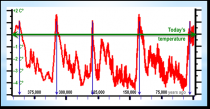Allan MacRae
Letter from Allan MacRae

Enlarged. See post here.
David Socrates asks on December 16, 2014 at 7:57 am
“Will all the folks saying that ∆CO2 follows ∆T ([temperature]. explain why in the past 15/16/17 years, ∆T = zero and ∆CO2 is 30-34 ppm?”
Already answered in my posts on this page David:
“I suggest that at a practical level, atmospheric CO2 lags temperature at all measured time scales.
In the modern data record, the rate of change dCO2/dt varies ~contemporaneously with temperature and CO2 lags temperature by about 9 months.
For verification, please see my 2008 paper.
CO2 also lags temperature by about 800 years in the ice core record on a longer time scale.
Therefore, CO2 lags temperature at all measured time scales. CO2 does not drive temperature; temperature (among other factors) drives CO2.
It appears that CO2 lags T at all measured time scales. This still allows for other significant drivers of atmospheric CO2, such as fossil fuel combustion, land-use changes such as deforestation, ocean outgassing, etc.”
********
The details of this issue have been ably argued on wattsup and other sites between Ferdinand Engelbeen and Richard S Courtney - one can search under “mass balance argument”.
The issue is one of magnitudes - how can we fully explain the current rise in atmospheric CO2 - your “∆CO2 is 30-34 ppm” - when the ∆CO2 magnitudes observed in both the modern data record and the ice core record in response to ∆T are allegedly too small to solely account for this 30-34 ppm CO2 - some parties allege that other drivers of this ∆CO2 such as fossil fuel combustion must also exist (and they may be right or wrong).
Many pages have been written and it is an interesting argument, which is of great scientific importance. However, for policy discussions I suggest all we really need to know is that global temperature T is clearly insensitive to increasing atmospheric CO2 concentrations, and the IPCC alarmists’ fear of catastrophic humanmade global warming is without scientific merit, and is highly counterproductive, wasteful and foolish.
As we clearly stated in our 2002 APEGA paper:
“Climate science does not support the theory of catastrophic human-made global warming - the alleged warming crisis does not exist.” Baliunas, Patterson and MacRae
Furthermore, increased atmospheric CO2 from whatever cause is clearly beneficial to humanity and the environment. Earth’s atmosphere is clearly CO2 deficient and continues to decline over geological time. In fact, atmospheric CO2 at this time is too low, dangerously low for the longer term survival of carbon-based life on Earth.
More Ice Ages, which are inevitable unless geo-engineering can prevent them, will cause atmospheric CO2 concentrations on Earth to decline to the point where photosynthesis slows and ultimately ceases. This would devastate the descendants of most current life on Earth, which is carbon-based and to which, I suggest, we have a significant moral obligation.
Atmospheric and dissolved oceanic CO2 is the feedstock for all carbon-based life on Earth. More CO2 is better. Within reasonable limits, a lot more CO2 is a lot better.
As a devoted fan of carbon-based life on Earth, I feel it is my duty to advocate on our behalf. To be clear, I am not prejudiced against non-carbon-based life forms, but I really do not know any of them well enough to form an opinion. They could be very nice. ![]()
Best, Allan
Icecap comment. This season beat out 2004 and 2009 for US crop yields with a global glut of produce. Ideal weather conditions combined with higher CO2 has improved productivity. CO2 is plant food. Even in drought ridden California, CO2 helped to limit losses by enhancing growth and reducing water needs. The losses would have been much greater with lower CO2 levels.


